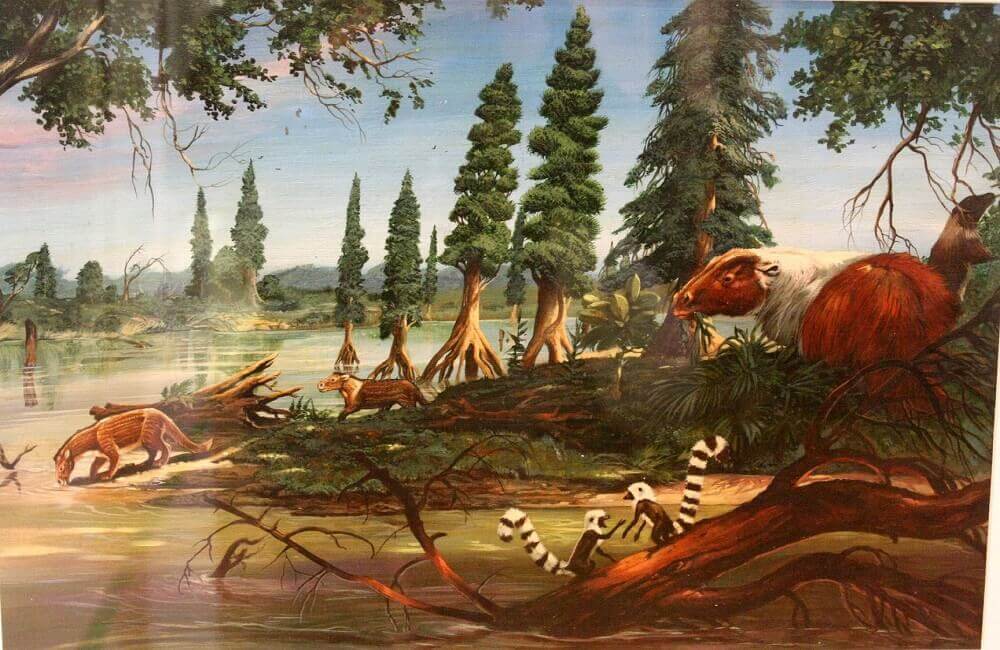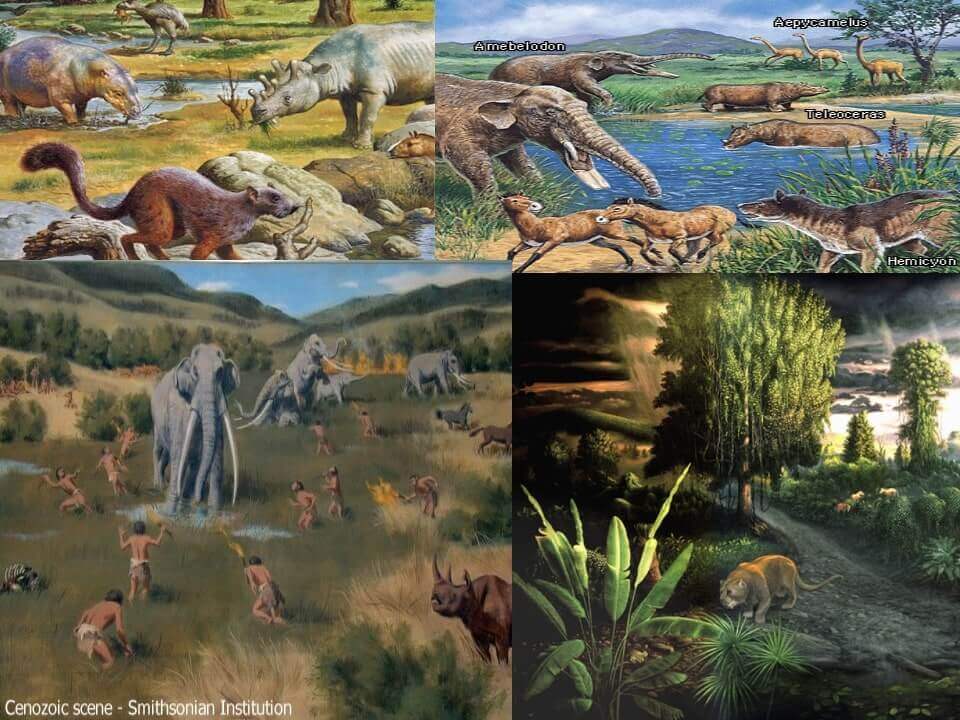
The Cenozoic Era is the most recent (and currently ongoing) Geological Era of the three major subdivisions of the history of life forms. The Cenozoic started approximately 65 million years from today, from the end of the Cretaceous Period in the Mesozoic Era (caused by an asteroid attack). The Cenozoic is sometimes called the Age of Mammals because the largest land animals have been mammals during that time. However, many people see this as an incongruity, and for many reasons. Primarily, mammal species existed long before the Cenozoic Era initiated. Moreover, the diversity of life during the Cenozoic Era is much more than just mammals. The Cenozoic can also be the “Age of Flowering Plants” or the “Age of Insects” or the “Age of Birds” just as accurately. Let’s learn a bit about Cenozoic era facts, its definition, timeline, plants, animals, climate, and more below.
Cenozoic Era Definition
To understand the meaning of the Cenozoic Era, we can split the word into two to make sense of it. The word “Ceno” derives from Greek, which means “recent”. The word “Zoic” means anything in relation to animals. Therefore, putting it together, “Cenozoic” means animals of the recent time period.
Cenozoic Era Timeline
The Cenozoic Era is broadly divided into three geological periods, namely: Paleogene Period (65 to 23 million years ago), Neogene Period (23-3 million years ago), and Quaternary Period (3 million years ago to present).
Paleogene Geological Period
The word Paleogene is derived from Greek, which translates to “ancient born.” In the Paleogene period, the previously dominant and omnipresent animals such as dinosaurs, pterosaurs, and giant marine animals were no longer present, which presented a drastic change in the evolution of species. In their places, smaller animals such as rodent-sized mammals started increasing in population and filling the tremendous landmass. The first whales also started forming in the Paleogene Period.
Neogene Geological Period
When the Neogene Period began, the earth started looking similar to it does today. Finally, greenery took over most of the landmass, making earth the “green planet” as we know it. Moreover, most of the mountainous landscapes took shape during the Neogene Geological Period. The arctic ice caps grew thicker and larger, and Antarctica became the continent with the most differentiated species as compared to other continents. Moreover, since the continents spaced out significantly, species that were once similar started evolving and specializing in their own landscape, varying significantly in their structure and intelligence.
Quaternary Geological Period
Quaternary Geological Period – which began over just under 3 million years ago (and continues to date) – is known for its constant climatic changes and varying sea levels. Glaciers accumulate at the poles reducing the water levels, then melt and increase the water level. This cycle continues, often resulting in climatic changes as well.
At the beginning of the Quaternary Geological Period, the continents were at nearly the same places as where they are today, though slowly moving (at a negligible scale) due to earth’s dynamic tectonics.
Fun Fact: Species similar to human species first appeared in Africa during the Quaternary Geological Period, about 200,000 million years ago, and quickly spread to Asia, Australia, Europe, and North and South America. However, they were unsuccessful in settling in Antarctica due to its extreme weather.
Cenozoic Era Climate
When the Cenozoic Era started, in the Paleogene Geological Period, the global temperatures were warmer than the middle and the present geological periods. Moreover, regardless of the equator and the poles, the temperature throughout was consistently warm. Furthermore, 56 million years ago, a thermal maximum took place – called Paleocene-Eocene Thermal Maximum. This was immediately followed by a period of cooling in the Neogene Geological Period. This cooling continued towards the current Quaternary Geological Period to establish the room temperature we have today. In modern times, we have seen the phenomenon of global warming due to our increasing artificial modification to nature. This is the first time in history that a species has directly impacted the climatic conditions of the earth to such an extent.
Major Events in the Cenozoic Era
There were various major events in the Cenozoic Era which were responsible for shaping the world as it is today. One of the major events was volcanic eruptions. Although there were many volcanic eruptions throughout the Cenozoic Era, there were seven major volcanic eruptions that made significant changes to the landmass. These eruptions took place in the middle of the Cenozoic Era, which is to say from 34 million years ago to 7 million years ago, in the high planes of North America. Furthermore, there has been one momentous meteor attack in the Cenozoic Era, which took place during the beginning and global warming period of the Cenozoic era. Moreover, there were tremendous changes in the tectonic plates and their movements were highly dynamic. The Atlantic Ocean continues to widen through the Cenozoic Era. These tectonic movements have also led to massive collisions of landmasses, resulting in the creation of the Himalayas, Alps, Andes, and the establishment of the mountains on the coast of the Pacific.
Life in the Cenozoic Era

Known as “The Age of Mammals”, the Cenozoic Era saw the extinction of many huge animals and allowed smaller species such as mice to evolve and live longer since their predators were endangered. At the start of the Cenozoic Era, that is in the Paleogene Period, many animals continued life in a similar state from the older geological era – Mesozoic Era. During this period, rodents and small horse-like mammals were omnipresent. As time passed and the Paleogene Geological Period came to an end, mammals such as cats, dogs, and pigs started evolving along with the Neogene Geological Period. This period saw early primate species, including species similar to monkeys and humans. Species similar to goats and sheep also evolved during this period. With the end of the Neogene Geological Period and initiation of the Quaternary Geological Period, the evolution of primate species paced higher and the evolution of wooly animals such as mammoths also started off.
Apart from animals, there was also a huge evolution in plant life through the Cenozoic Era. With the end of large animals such as dinosaurs, plants now had only a few animals to crush them down, such as elephants. This allowed them to live longer and thus have more time for evolution. Almost all the species of flowers we know today evolved during the Cenozoic Era. Forests started overrunning most of the land areas, including the Americas, during the early Cenozoic Era. However, as the temperature started cooling off, the forests started reducing in volume and created barren lands and grasslands.
A large evolution in marine life was also seen during the Cenozoic Era. Due to the spreading of landmasses and the formation of continents in the Cenozoic Era, the water bodies were briefly divided between the continents. This led to the evolution of water mammals such as whales. It also gave rise to large sharks. There were more rivers, lakes, and ponds, which gave rise to more fresh-water marine species and allowed speciation of marine life at a higher pace.
Cenozoic Era Fossils
Although the Cenozoic Era is currently ongoing, we still have fossils that help us track the start and gradual progression of life in the third geological era. The fossils found in the Cenozoic Era are classified as “recent fossils”. We have been able to find fossils from all the geological periods, including in the Quaternary Geological Period, such as pecten gibbus and neptunea tabulata, and the Tertiary period, calyptraphorus velatus, and venericardia planicosta. Pecten gibbus are index fossils found in the Cenozoic Era in the Quaternary period, 1.8 million years ago. Pecten gibbus fossils appear extremely similar to the seashells that we often find lying on the beaches, which show how the evolution of shells started about 2 million years ago.
There are various Cenozoic Fossil Localities as seen in the list below:
Bodjong Formation, Indonesia: Deep-water mollusks from this locality have given us a picture of past tropical marine life in what is today a very species-rich area.
Creede Formation: An extensive plant community from this locality in Colorado includes pine, fir, barberry, and a variety of other species.
Florissant Formation: This locality lies in the Rocky Mountains of Colorado, which remarkable insect fossils.
Green River Formation: Rich in fossils of plants, insects, and fish, this locality stretches across Utah, Colorado, and Wyoming.
Rancho La Brea Tar Pits: One of the most famous fossil localities, La Brea is an asphalt seep containing Pleistocene fossils located in Los Angeles.
Monterey Formation: Vast area of exposed Miocene outcrops in California. Fossils include macroalgae, microfossils, shells, crabs, and porpoises.
Villavieja Formation, Colombia: To date, our only good source of information about Tertiary animals in the South American tropics is this site in Colombia. Many of the pre-Pliocene animal groups represented have been found nowhere else outside of the continent.
To conclude, the Cenozoic Era appears to be highly intriguing amongst the three geological eras. With life reaching its paramount position in terms of evolution and intelligence – humans being the best example – the Cenozoic Era is home to the most life forms ever on earth’s history, with varying temperature scales and sea levels throughout its time span.
From the extinction of non-avian dinosaurs to humans taking charge, from almost all life forms being extinct in the marine ecosystem to the rapid evolution of mammals as sea creatures, from uncovered seeds to flowering plants, the transition from Mesozoic Era to Cenozoic Era has been fruitful for the evolution of life forms, and even after the disastrous meteor attack that ended the Mesozoic Era, life forms rebuilt themselves, falling together to make the beautiful world we have today.
Reference::
https://www.livescience.com/40352-cenozoic-era.html
https://www.britannica.com/science/Paleogene-Period
https://www.nationalgeographic.com/science/prehistoric-world/paleogene/
https://www.nationalgeographic.com/science/prehistoric-world/quaternary/
You May Also Like To Read:
Paleozoic Era: Definition, Facts, Timeline, Climate And Animals
Mesozoic Era: Definition, Facts, Timeline, Plants, Animals, And How It Ended
